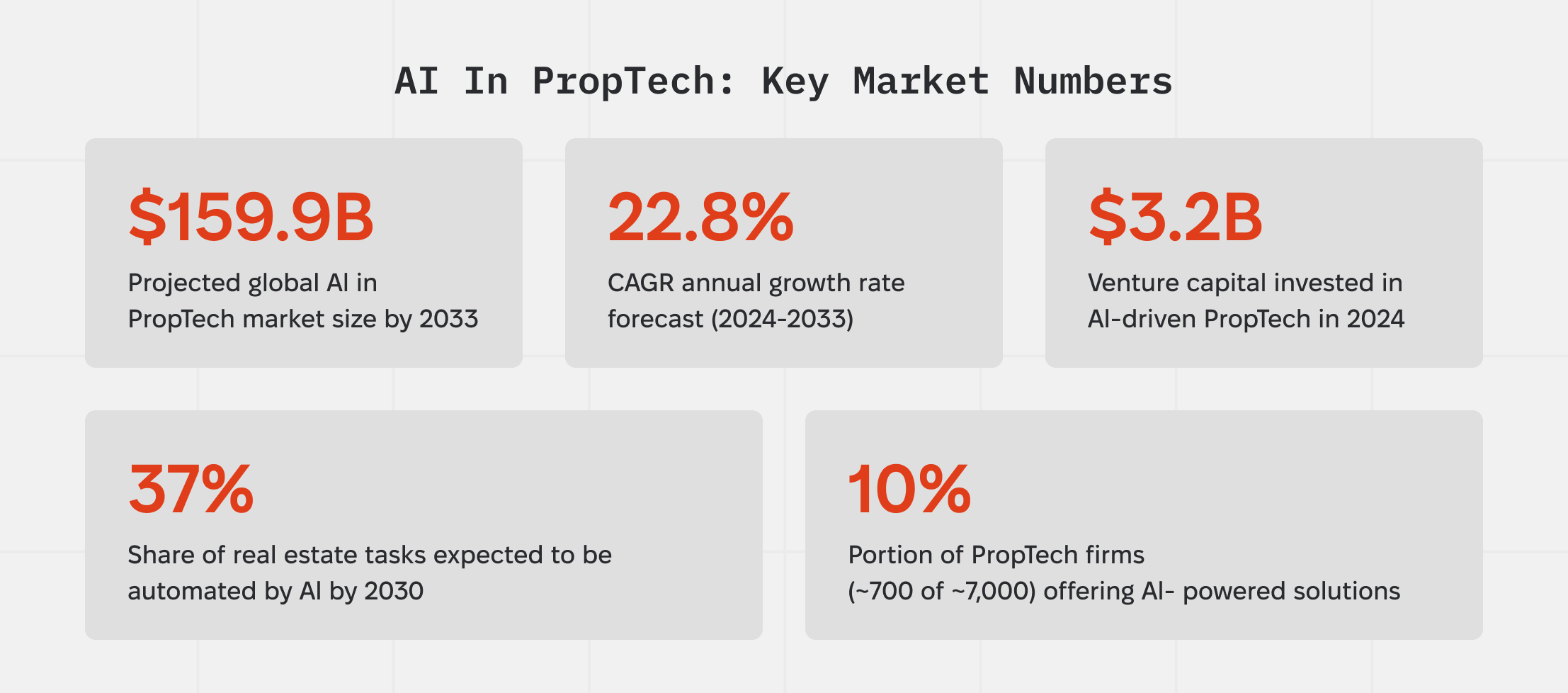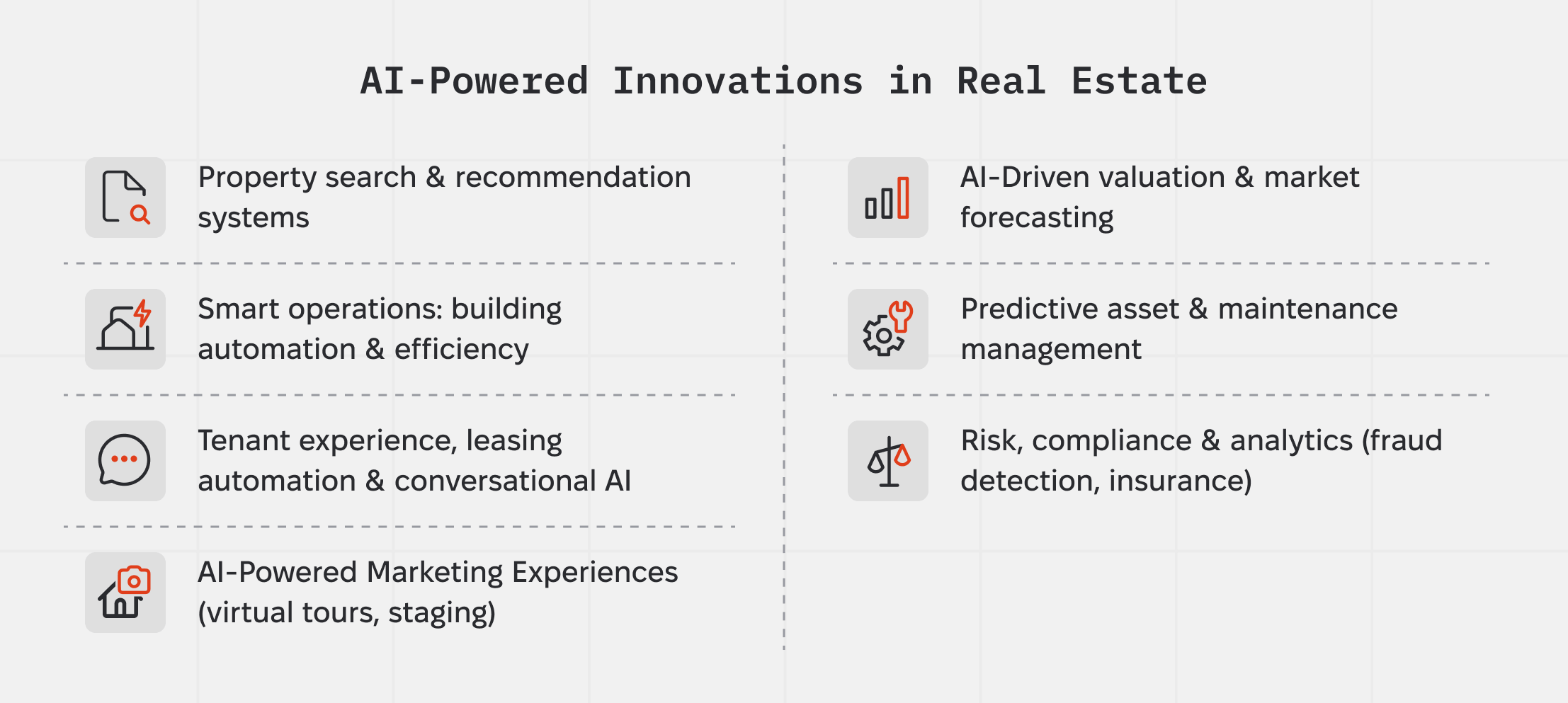Rising interest rates, tighter margins, and growing asset complexity have always haunted real estate and PropTech firms. But solving these problems has become far more accessible than ever before.
In that shift, AI comes into play as a daily utility. It now drives property assessments, forecasts market trends, automates lease reviews, monitors building systems, and personalizes tenant communication. What once took large teams and weeks of manual effort now happens in hours, with more accuracy, context, and confidence.
Why AI
AI is everywhere now—that much is clear. The real questions are what benefits it brings, how it can be applied in practice, and what’s next for the industry. That’s what we’ll explore here.

1. Data Now Drives the Market
Data in real estate keeps multiplying—tenant behavior, sensor readings, transaction logs, market signals. It’s too much for people to process manually, and that’s where AI fits naturally. It turns scattered data into insight that helps teams move faster and work smarter.
Studies show AI could automate up to 37% of real estate operations, saving the industry around $34 billion in efficiency gains by 2030. Investors are catching on too: AI-powered PropTech firms raised about $3.2 billion in 2024, a clear sign that confidence—and urgency—are both rising.
2. Next Wave of Value Creation with AI
AI adoption goes far beyond cost reduction. It opens the door to sharper asset valuation, smarter risk assessment, hyper-personalized tenant and occupier experiences, predictive maintenance, and dynamic energy optimization. These capabilities don’t just improve efficiency—they redefine how real estate firms compete and deliver value. Generative AI alone is projected to create $110–180 billion in additional value across the real estate industry.
VTS CEO, Nick Romito: “AI is rapidly augmenting investment, strategy, and operations in all corners of commercial real estate. Looking broadly, the largest value for AI in the industry is centered in giving teams time back to complete more of their essential day-to-day tasks that generate the most ROI for their respective businesses. With VTS AI, we focused on addressing the most critical pain-points of our customers by automating manual processes and streamlining data to not only maximize efficiency but also ensure the best data strategy.”
3. Timing: Risk of Being Left Behind
More firms are already moving from talk to testing. In one survey, 61% of commercial real estate companies reported running AI pilots. The window to lead or simply stay relevant is closing fast. In this environment, doing nothing has become a strategic risk.
4. The Tech Foundation Is Ready
What makes AI adoption feasible today is the maturity of the surrounding ecosystem. Cloud infrastructure, IoT sensors, building data platforms, and advanced AI models (ML, computer vision, NLP) have all reached a level of reliability that supports real deployment. With pre-built solutions and scalable frameworks now widely available, PropTech firms are better positioned than ever to implement and grow AI-driven capabilities.

Key AI Features in PropTech
AI is changing the way properties are found, run, and make money.
Cotality Сhief Data and Analytics Officer, John Rogers : "The value in AI isn't just in the technology—it's in the human connection it restores. By immediately handling high-volume tasks—from precise roof analytics to predictive 30-year climate modeling—our solutions deliver granular intelligence in moments. This doesn't just cut costs; it gives professionals the most valuable asset: time to sit down with their clients and use that data to counsel them on mitigation strategies, reinforce long-term resilience, and confidently design innovative policies. That's the AI difference: turning data processing into people-focused strategy."
This section highlights the key AI features across proptech real estate — from search and valuation to operations, maintenance, tenant experience, risk management, and immersive marketing.
Property search & recommendation systems
AI platforms analyse users’ past behaviour (searches, clicks, saved listings) + listing attributes (location, size, amenities) to build segmented preference profiles. Then, the system surfaces and ranks listings with highest relevance — reducing search time and leading candidates. These systems may also allow natural-language or voice search (e.g., “three-bedroom near good schools under €400k”) and dynamically adjust filters based on inferred preferences.
AI-Driven valuation & market forecasting
Automated Valuation Models (AVMs) use historic transactions, property and neighbourhood attributes, economic indicators and real-time signals to estimate property value and forecast trends. By ingesting large data sets, the models provide value estimates, rental/yield projections or market movement predictions — supporting investment decisions, pricing strategy and portfolio management.
For example, ApartmentIQ applies AI to multifamily housing data, providing accurate, daily insights that guide pricing and investment decisions.
ApartmentIQ/MavenAI Head of Marketing, Jeannie Cambria: "ApartmentIQ is the multifamily rental housing industry's leading market data solution - with five years of public data and over 37 million units tracked across the country. ApartmentIQ Market Surveys provides unmatched accuracy and transparency into every market, competitor, and unit, every day. Designed to help your team make data-driven decisions that optimize revenue, refine pricing strategies, and outpace the competition, ApartmentIQ proprietary AI analyzes and validates each data point to ensure the cleanest, most accurate data set, down to the unit level at the properties you track."
Smart operations: building automation & efficiency
Buildings embedded with IoT sensors (occupancy, lighting, HVAC, energy use) feed data into AI‐driven operational systems which optimise settings (temperature, lighting, ventilation) based on usage patterns and forecasts. The result: improved tenant comfort, energy/cost savings and fewer manual interventions when systems operate adaptively and autonomously.
A good example comes from TurboTenant, which uses AI to streamline maintenance triage and reduce costly back-and-forth between landlords and tenants.
TurboTenant CEO, Seamus Nally: “We’re seeing AI shift from simply improving back-office efficiency to actually driving revenue. A great example is our AI-powered Maintenance Triage at TurboTenant. Traditionally, maintenance requests come in missing key details, leading to costly back-and-forth between landlords and tenants. Since landlords spend an average of 10 to 15% of their gross rental income on maintenance each year, resolving even one or two basic issues upfront can translate into meaningful savings. Our AI engages tenants with a few targeted questions and simple self-checks, resolving many problems on the spot. When a service call is needed, it automatically generates a complete, actionable request so landlords can dispatch the right pro without delay. It’s a powerful way we’re using AI to remove friction, save money, and solve problems proactively for landlords.”
Predictive asset & maintenance management
Rather than reacting to equipment breakdowns, predictive maintenance uses sensor data (vibration, temperature, run‐hours), maintenance logs and usage patterns. AI flags components likely to fail soon, triggers work orders ahead of time, optimizes service schedules and reduces downtime or unplanned costs.
Tenant experience, leasing automation & conversational AI
Tenant-facing AI tools handle enquiries, schedule viewings, answer FAQs, guide leasing workflows, renewals, and payments. Automation of leasing documentation, combined with chatbot/voice interfaces, enhances responsiveness and personalisation of tenant service, freeing staff to handle strategic tasks rather than routine admin.
Risk, compliance & analytics (fraud detection, insurance)
AI systems analyse property attributes, transaction patterns, external data (e.g., climate risk, credit history, claims) to identify anomalies (fraud), assess underwriting risk, monitor compliance and produce risk scores. This supports insurers, owners or asset managers in making informed, data-driven decisions.
AI-Powered Marketing Experiences (virtual tours, staging)
Generative AI creates rich marketing content — from virtual staging (furnished interiors from empty rooms) to generated property descriptions and 3D/VR walkthroughs. These immersive tools help buyers/tenants visualize spaces remotely, tailor visuals to buyer profiles, and accelerate decision-making by enhancing engagement and presentation.
Implementation Considerations
Data Architecture, Quality & Integration
AI adoption in PropTech starts with the data layer. Property information is fragmented—spread across MLS feeds, IoT sensors, leasing systems, and public registries. Without a unified data model, AI outputs stay inconsistent.
Modern platforms (e.g., Cherre, Reonomy) address this by mapping billions of records into normalized data lakes that connect ownership, transaction, and geospatial layers. This architecture allows real-time analytics across sources once handled in silos.
Data quality is a recurring barrier. Duplicates, missing attributes, or outdated tax data can distort models by up to 20–30% in valuation accuracy. Companies that invested early in automated data cleansing and entity resolution (e.g., CoreLogic’s Cotality and Zillow’s data pipelines) show faster deployment and fewer retraining cycles.
The practical takeaway: before scaling AI, invest in structured data governance—clear ownership of inputs, version control for datasets, and consistent schema mapping to RESO or similar standards. Integration, not algorithms, is often the bottleneck.
Change Management: Skills, Processes & Culture
Deploying an algorithm is easy; changing how teams use its output is not. That shift will require retraining facility managers to interpret AI dashboards, adjust workflows, and report anomalies instead of overriding controls. Change management should cover three layers:
- Skills: Upskilling property analysts and managers in data literacy and AI system interpretation.
- Processes: Embedding AI insights into leasing, maintenance, and investment workflows so outputs trigger real actions.
- Culture: Moving from “gut-based” to “data-led” decisions. Leaders need to model this behavior—using AI reports in reviews and tying performance metrics to data-driven outcomes.
Ethical, Legal & Transparency Issues
AI in real estate directly affects pricing, lending, and tenant decisions—areas already under regulatory scrutiny. Poorly monitored algorithms can reinforce bias (e.g., undervaluing neighborhoods or excluding certain borrower profiles).
Regulators are catching up. In the U.S., HUD and CFPB have begun reviewing automated valuation and lending models for fairness and explainability. The EU AI Act classifies property valuation and credit scoring under “high-risk” AI systems, requiring auditable data sources and transparent model logic. For PropTech firms, that means:
- Model transparency: Document inputs, assumptions, and version history.
- Bias testing: Regularly audit models for geographic or demographic skew.
- Data protection: Comply with GDPR/CCPA for tenant and transaction data, especially when using computer vision or IoT sensors.

Future Outlook
AI in PropTech is evolving from process automation to contextual intelligence—systems that understand how market forces, building data, and human behavior interact. The next wave is less about deploying tools and more about creating self-improving ecosystems that connect valuation, operations, leasing, and investment into one adaptive framework.
Convergence of AI, IoT, and Building Intelligence
Buildings are becoming continuous data environments. AI no longer reacts to events; it anticipates them. Through sensor fusion and predictive modeling, building systems now self-regulate—adjusting temperature, lighting, and ventilation to balance comfort, occupancy, and energy cost. Platforms like BrainBox AI, Infogrid, and Facilio illustrate this shift toward autonomous, feedback-driven control systems. The underlying trend is toward “living buildings” that use machine learning loops to fine-tune performance without human input.
Rise of Agentic and Autonomous AI
Agentic AI represents a structural leap beyond automation. These models perform multi-step tasks—renegotiating leases, scheduling repairs, or reconciling budget data—by chaining reasoning, memory, and action. In PropTech, this means systems that can execute full workflows, not just assist them. Companies like Northspyre and REAi already integrate autonomous decision-making into project management and property matching. Over time, such systems will evolve from decision support to operational command, handling transactions and negotiations with minimal oversight.
Generative and Multimodal AI for Market and Tenant Engagement
Generative AI is redefining how information is produced and consumed. In PropTech, it synthesizes unstructured data—property visuals, contracts, user queries—into clear narratives and insights. It’s moving from simple content creation to context-aware interaction, where agents can analyze imagery, detect condition issues, and generate asset summaries on demand. Combined with computer vision and NLP, these models personalize engagement across leasing, marketing, and investor relations at scale.
Data Consolidation as a Strategic Asset
Data, not algorithms, will determine market leadership. The recent acquisitions by CoStar, JLL, and CoreLogic signal a consolidation race for proprietary datasets and unified data architectures. Firms are building vertically integrated intelligence stacks—linking valuation data, spatial analytics, and climate models under one platform. This convergence creates barriers to entry and enables differentiated insights competitors can’t replicate.
Regulatory and Ethical Maturity Driving Trust
The next market advantage will come from transparency as much as technology.
With valuation, lending, and tenant analytics now classified as “high-risk” under emerging AI regulations, credibility will hinge on how explainable and auditable a system is. Companies that invest early in ethical model governance—bias checks, explainability frameworks, and compliant data practices—will earn a trust advantage with regulators, lenders, and institutional investors.
Conclusion & Key Takeaways
AI now runs through every part of real estate. It handles valuations, maintenance, leasing, and data analysis. The smartest PropTech firms treat it as core infrastructure, not an add-on.
Key Takeaways
- Operational integration defines maturity. Firms deriving measurable outcomes from AI treat it as a system capability embedded in their processes, not as a standalone project.
- Data foundations are strategic assets. Clean, standardized, and interoperable data models underpin accuracy, scalability, and competitive differentiation.
- Governance ensures resilience. Transparent model management, bias testing, and compliance readiness are now prerequisites for institutional adoption.
- Human oversight remains decisive. While AI enhances precision and speed, strategic reasoning and contextual judgment continue to anchor high-value decisions.
In the next wave of PropTech, the winners will be the ones who use tech wisely and stay grounded in real results.







.png)
.png)

.avif)







